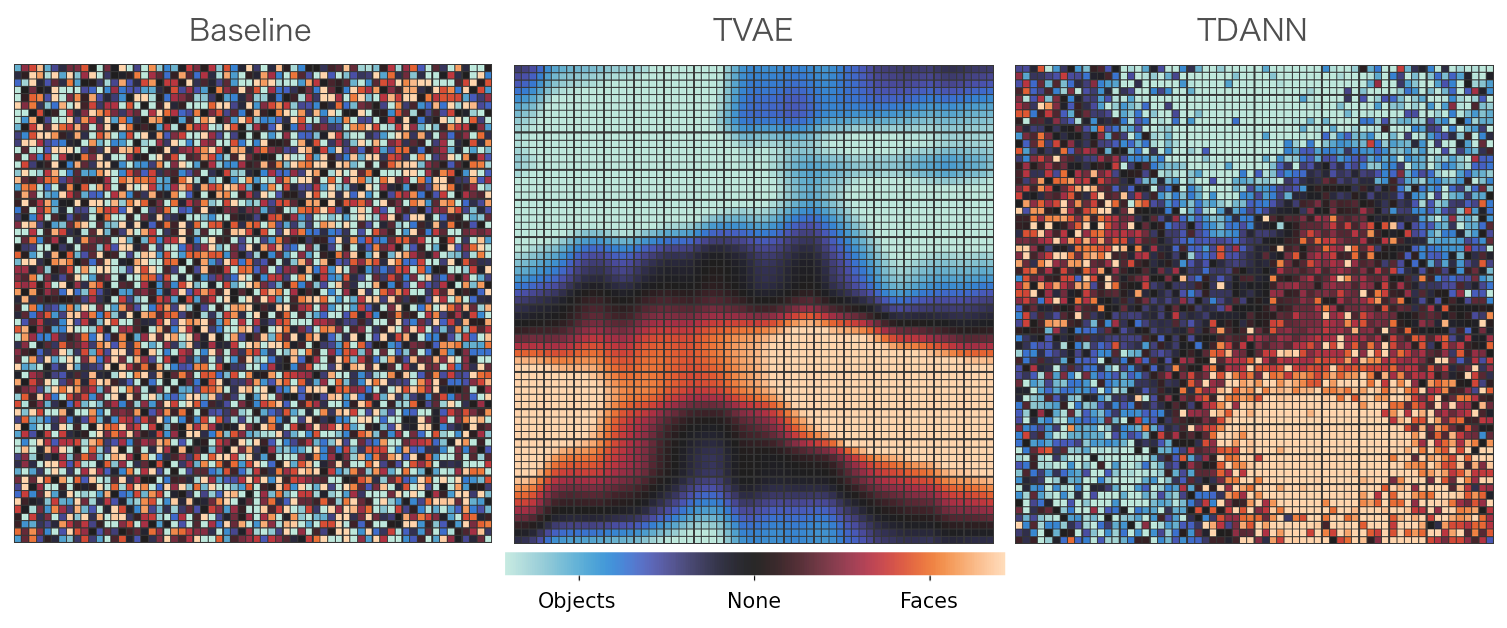Modeling Category-Selective Cortical Regions with Topographic VAEs
 Measurement of selectivity of top-layer neurons to images of Faces vs. images of Objects. The baseline pretrained Alexnet model (left) has randomly organized selectivity as expected. We see the Topographic VAE (middle) yeilds spatially dense clusters of neurons selective to images of faces, reminiscent of the ‘face patches’ observed in the primate cortex. The TVAE clusters are seen to be qualitatively similar to those produced by the supervised TDANN model of Lee et al. (2020) (right) without the need for class-labels during training.
Measurement of selectivity of top-layer neurons to images of Faces vs. images of Objects. The baseline pretrained Alexnet model (left) has randomly organized selectivity as expected. We see the Topographic VAE (middle) yeilds spatially dense clusters of neurons selective to images of faces, reminiscent of the ‘face patches’ observed in the primate cortex. The TVAE clusters are seen to be qualitatively similar to those produced by the supervised TDANN model of Lee et al. (2020) (right) without the need for class-labels during training.
Category-selectivity in the brain describes the observation that certain spatially localized areas of the cerebral cortex tend to respond robustly and selectively to stimuli from specific limited categories. One of the most well known examples of category-selectivity is the Fusiform Face Area (FFA), an area of the inferior temporal cortex in primates which responds preferentially to images of faces when compared with objects or other generic stimuli. In this work, we leverage the newly introduced Topographic Variational Autoencoder to model of the emergence of such localized category-selectivity in an unsupervised manner. Experimentally, we demonstrate our model yields spatially dense neural clusters selective to faces, bodies, and places through visualized maps of Cohen’s d metric. We compare our model with related supervised approaches, namely the TDANN, and discuss both theoretical and empirical similarities. Finally, we show preliminary results suggesting that our model yields a nested spatial hierarchy of increasingly abstract categories, analogous to observations from the human ventral temporal cortex.
T. Anderson Keller, Qinghe Gao*, Max Welling
Best Paper Award at NeurIPS 2021 workshop on Shared Visual Representations of Humans and Machines
Arxiv Paper: https://arxiv.org/abs/2110.13911
Github.com/AKAndykeller/CategorySelectiveTVAE
Oral Presentation
Tweet-print
Can specialized ‘patches’ in the brain be described by the efficient coding hypothesis?
Together with @qinghegao and @wellingmax, we show how localized selectivity arises naturally from the principle of redundancy reduction in Topographic VAEs:
📃 https://t.co/zHrfDsgny6
🧵/ pic.twitter.com/N0MkXiUmKC— Andy Keller (@t_andy_keller) November 2, 2021